Articles - Page 2:
EARLY WATER SOURCES FIRE CRIME
LAW ENFORCEMENT HOTELS SOME EARLY CLUBS
KU KLUX KLAN M.H. HAGAMAN CIVIC IMPROVEMENTS
JOHN McCLESKEY MOVIE THEATERS EARLY SCHOOLS
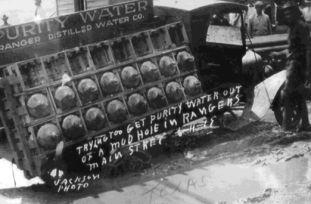 EARLY WATER SOURCES - The
lack of a dependable
source of water was a
major problem confronting
the new settlement of
Ranger. One of the first
attempts at solving the
problem was a well dug in
the middle of Locust Street
(later called Main Street)
about half a block west of
the present intersection
of Main & Commerce Streets.
EARLY WATER SOURCES - The
lack of a dependable
source of water was a
major problem confronting
the new settlement of
Ranger. One of the first
attempts at solving the
problem was a well dug in
the middle of Locust Street
(later called Main Street)
about half a block west of
the present intersection
of Main & Commerce Streets.
The well was not a success: the water had so much mineral content
that it wasn’t useful for domestic consumption, and even livestock
were reluctant to drink it.
Another early source of water was the “Rock Hole,” as it was called,
in Bull Hollow, which was eventually dammed to form Hagaman Lake.
Cisterns supplied some water, and still another source was the “Big
Hole” in Colony Creek near present-day Merriman. Much like the
milkman of later days, the “waterman” made the rounds distributing
water to customers.
Before there was a dependable municipal water supply, some drinking
water was shipped in from Mineral Wells and sold for 75 cents a
barrel. Vendors sold water for 5 to 10 cents a glass downtown. One
water supplier was Ranger Distilled Water Company, which sold what
it advertised as “purity” water.
Ranger Water Works Company was organized in 1898. It used as its
source what was known as the Rice tank (the owner was Ranger business-
man J. M. Rice), about a half mile west of the business district.
Another source of water was the Riddle tank (I could not verify the
location), which was used to supply cotton gins and possibly some
residences. Ranger Water Works Company was able to take care of
Ranger’s water needs fairly adequately from these sources until the
oil boom, when a huge increase in population made another solution
necessary.
M.H. Hagaman, businessman and rancher, had built a dam across Bull
Hollow before the oil boom, forming what became known as Hagaman
Lake. Texas Pacific Railway Company had laid pipes from the Lake
to Ranger and was using the water for its engines.
The Company agreed to allow the city to use Texas Pacific Railway
Company pipes to bring water into town for municipal use. M.H.
Hagaman founded the Hagaman Water Works Company. The Company’s
filtration plant at the Lake could handle 600,000 gallons a day.
Hagaman Lake remained Ranger’s source of water until Lake Leon,
dedicated in 1955, took its place. Photo courtesy of Ranger
Historical Preservation Society.
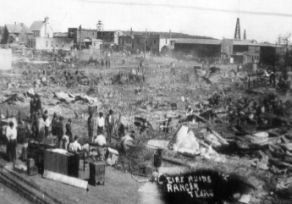 FIRE - Ranger had little
fire protection in the
early days, especially
before there was a
reliable municipal water
supply. Before the city
incorporated in 1919 and
got what was at the time
considered modern fire-
fighting equipment, fire-
fighting was done by
volunteers, often in bucket
brigades. Sometimes fire-
FIRE - Ranger had little
fire protection in the
early days, especially
before there was a
reliable municipal water
supply. Before the city
incorporated in 1919 and
got what was at the time
considered modern fire-
fighting equipment, fire-
fighting was done by
volunteers, often in bucket
brigades. Sometimes fire-
fighting consisted of several men running into a burning building
and carrying out everything they could. One early newspaper
account described how men rushed into a burning saloon and
carried out the bar.
Fires leveled entire blocks. A major fire on April 6, 1919 destroyed
buildings between Rusk and Marston Streets on the north side of Main
Street (pictured here). Another fire sometime in 1920 destroyed
several buildings on Pine Street. Fires were devastating because
of the lack of equipment and water and the fact that many of the
buildings were wooden.
Ordinances were passed requiring new construction in the commercial
area to be fireproof. Ironically there was still enough wood and
other flammable material in these “fireproof” buildings that a number
of them eventually burned. A 1920 newspaper article reported on
four fires on the same day that destroyed the El Paso Hotel, a
residence, and a stable of 32 fine draft horses and threatened
buildings in the downtown area. The McCleskey Hotel, Ranger’s
pre-eminent hotel during the oil boom, burned in 1924 with the
loss of four lives.
Oil field fires were all too common. One of the major oil field
fires destroyed oil storage tanks at the Brewer farm at Merriman,
and a number of employees of the Texas Pacific Coal and Oil Company
were killed. Before enclosed storage tanks were put in, oil was
moved from a well to an earthen tank usually via an open ditch. An
eyewitness recalled that about a hundred men were standing around
a well watching the oil moving through the ditch when a bystander
started to light a cigarette. Another bystander knocked the cigarette
and match from the would-be smoker’s hand, likely averting a major
tragedy.
It was extremely dangerous to smoke around an oil well. A group of
oil field workers erected a shanty away from the oil field where
they were working so they would have a safe place to smoke. They
put a sign on their shanty that read “the Ranger Country Klub.
CRIME - Like all other oil boomtowns, Ranger attracted criminals.
Gamblers, thieves, prostitutes, pimps, robbers, hoodlums, and all
other kinds of criminals arrived in Ranger eager to make quick
money and lots of it. Gunfights and murders were common: in one
24-hour period there were five murders. It was not uncommon to
see dead men sprawled in the street. It was said that the police
chief counted 66 “reported” murders and suicides in 1919—and
then gave up counting! A 1919 Ranger Daily Times had a news
item: “Police were so busy Sunday rounding up a gang of alleged
highwaymen that they had little time to devote to misdemeanors.”
Although the “wild West” was past, hip-holstered, gun-toting men
were common sights. Policing, always a potentially dangerous
occupation, was even more so during the boom.
A 1919 Ranger Daily Times article reported the killing of Alf
Jordan, member of the police force, by Bill Shamlin, who had
been under investigation in a $20,000 blackmail scheme and a
bootlegging operation and otherwise figuring prominently in
police records. In 1921 the Texas Rangers raided the Commercial
Hotel in Ranger. The hotel was widely known throughout the
area as a public gambling house and saloon. As a result of
that raid 87 gamblers were arrested, and eight gambling tables
and other gambling paraphernalia were seized. Sometime after
incorporation Ranger voted in a local option election to
outlaw liquor, but it continued to be available. In 1922
aroused citizens poured into the streets $16,000 worth of
liquor seized by the Texas Rangers in illegal bars & gambling
houses. The Rangers closed those places as well as houses of
ill repute and ran undesirables out of town. Various citizen
groups in Ranger continued to fight for rigid law enforcement,
and even the Ku Klux Klan, active in Ranger during the oil
boom, campaigned against what it described as “immorality
and continuing lawlessness.”
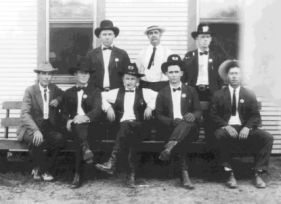 LAW ENFORCEMENT - Law
enforcement in Ranger
Camp Valley was in the
hands of the Texas
Rangers. They provided
protection against frequent
Indian raids and bandits
in sparsely settled com-
munities. Even after Ranger
had a police force, the
Texas Rangers continued to
be involved in resolving
some crimes, such as
LAW ENFORCEMENT - Law
enforcement in Ranger
Camp Valley was in the
hands of the Texas
Rangers. They provided
protection against frequent
Indian raids and bandits
in sparsely settled com-
munities. Even after Ranger
had a police force, the
Texas Rangers continued to
be involved in resolving
some crimes, such as
raiding gambling dens, brothels, and speakeasies, rounding
up their operators, and running them out of town.
Texas Rangers thwarted the only train robbery attempt in
Eastland County. In 1882 a robbery on an express train
was attempted while the train was in Ranger. Tipped off
about a possible robbery, Texas Rangers were aboard and
began shooting when they saw the robbers. In 1921 the
Rangers raided a gambling operation in the Commercial Hotel.
Texas Rangers would typically solve a crime and then would
leave town to go to another community that needed their
services. However, during the oil boom several Rangers were
stationed in Ranger. Local police were involved in some of
the same law enforcement as the Texas Rangers but were also
responsible for dealing with fights, drunken offenders,
general rowdiness, and other misdemeanors. Many citizens
felt that the police were not as rigorous in enforcing laws
as they should be, and the Ku Klux Klan, active in Ranger
during the oil boom, decried the continuing “immorality and
general lawlessness.”
Law enforcement often did indeed seem spotty. For example,
former Texas Ranger Byron Parrish, promising to rid Ranger
of “gambling, soliciting, wide-open cabarets, and gun-toting,”
was appointed chief-of-police in late 1919. Scarcely two
months after his appointment, city commissioners put him on
probation for failure to close gambling houses, and he was
eventually dismissed. Chiefs-of-police came and went with
some frequency in those days. The Ranger Daily Times reported
that there were 16 chiefs-of-police within 47 months, from
February 1919 to January 1923.
Law enforcement in Ranger as in other boomtowns could be
viewed ambiguously. If laws were enforced rigorously, then
certain entertainment and the income of those involved would
be adversely affected: for example, after local option,
speakeasies and nightclubs would theoretically be closed
for selling illegal liquor. However, if the police overlooked
these places, they could be accused of encouraging the growth
of organized crime. In oil boomtowns it was commonly thought,
sometimes with justification, that police were involved in
bribery and bootlegging.
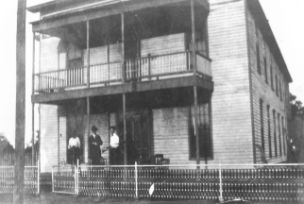 HOTELS - In her
History of Eastland
County, Texas (Dallas,
A.D. Aldridge, 1904),
Mrs. George Langston
said that a Mr. Griffin
“did a thriving hotel
business” in a tent
beginning around 1880.
Another early hotel was
run by Mr. and Mrs.
John Bryant from
Illinois. They began
HOTELS - In her
History of Eastland
County, Texas (Dallas,
A.D. Aldridge, 1904),
Mrs. George Langston
said that a Mr. Griffin
“did a thriving hotel
business” in a tent
beginning around 1880.
Another early hotel was
run by Mr. and Mrs.
John Bryant from
Illinois. They began
serving meals under a tent but eventually built a two-story
hotel just east of the downtown area on what was then South
Front Street, later Highway 80. The Bryant Hotel (pictured
here) remained Ranger’s foremost hotel until the oil boom,
when the Bryants retired.
Ranger was ill prepared to deal with the masses of people
coming into town drawn by the oil boom. Hotels and rooming
houses sprang up, but they were inadequate to cope with the
influx. Men slept in hotel rooms in shifts, and they paid
to sleep in chairs in hotel lobbies. The scarcity of hotels
was common in oil boomtowns. In some, men not only slept in
shifts and paid to sleep in hotel lobby chairs but also slept
on cots in hotel hallways and paid to sleep in barber chairs.
John McCleskey, newly wealthy from the oil well that ushered
in Ranger’s oil boom, built the McCleskey Hotel, which opened
in 1918 (construction cost $32,000) & quickly became Ranger’s
pre-eminent hotel. Oil deals worth hundreds of thousands of
dollars were said to have been conducted in the McCleskey Hotel.
It became so popular that an annex eventually had to be built.
The annex was a tent, and clients slept on cots. The hotel
burned down in 1934. The Gholson Hotel, built by John Gholson,
opened in 1921. Another early major hotel was the Paramount
Hotel. The Little Jim Hotel catered to blacks but sold barbecue
to a wider clientele.
Buckley Paddock’s History of Texas: Fort Worth and the Texas
Northwest (Chicago, Lewis Publishing Company, 1922) said that
Ranger had 26 hotels (presumably about the time of the book’s
publication). By the early 1940’s there were three hotels,
according to an undated brochure issued by the Ranger Chamber
of Commerce. The same brochure reported twelve tourist courts
and four trailer parks. For years major hotels would publish
in the newspaper a list of their clients and where they were
from.
Just as today, hotels advertised to attract customers. The
Paramount Hotel, for example, advertised its “beautiful tile
baths, sensible rates, and air conditioning.” It noted that
the Paramount Coffee Shop was open 24 hours a day. It touted
the “hot biscuits, chicken and dumplings noon and night, and
juicy steaks.” The cooks were women, the ad said. Photo
courtesy of Ranger Historical Preservation Society
SOME EARLY CLUBS & OTHER ORGANIZATIONS - A number of clubs
and other organizations began before the oil boom, and still
more were founded after the boom. The 1903 Club, a women’s
literary club, was one of the early clubs. It developed into
the 1920 Club, which in turn spawned three other literary
and study clubs: the New Era, Junior New Era, and Columbia
Study Clubs. The motto of the 1920 Club was especially
poignant: “Knowledge comes, but wisdom lingers.”
The Masonic Lodge in Ranger was chartered in 1892. Among
other early clubs were the Lions, Rotary, Child Welfare Club,
Elks, Odd Fellows, and Rebekah Lodge. La Societé des Quarante
Hommes et Huit Chevaux (the Society of Forty Men and Eight
Horses) was a men’s social club.
Among its other civic accomplishments, the Rotary Club was
instrumental in organizing three Boy Scout troops in Ranger
in 1927. The Ivy Leaf Study Club was an auxiliary of the
Eastern Star. Ranger’s Parent-Teacher Association was
organized at Young School in 1919. The P.T.A. in turn
organized the Child Study Club, whose purpose was to study
and discuss the problems of the pre-school child.
Many of the early clubs and organizations made major con-
tributions to Ranger’s welfare. For example, the 1920 Club,
the New Era Club, and possibly others established student
loan funds. The Child Welfare Club, established in 1921,
helped place a health services nurse in the public schools,
raised funds to send handicapped children to children’s
hospitals for treatment, distributed milk to undernourished
children, and set up a day nursery. The work of the Club
over a several year period was so outstanding that its
accomplishments were recognized by the State Welfare Board
and at the national level. The Club’s slogan at Christmas-
time was: “No child in Ranger should go without clothing,
food or toys.”
The Carl Barnes Post No. 69 of the American Legion was
organized in 1923 & was involved in many civic improvements.
The Ranger Chamber of Commerce was organized in 1918 with
25 charter members. By late 1919, it had 300 members. The
Retail Merchants Association was founded in the early 1920s.
A Ranger unit of the Texas National Guard was organized in
1928.
KU KLUX KLAN - Ranger was the center of activity for the Ku
Klux Klan in Eastland County in the early twenties. The
first Klan movement had flourished during Reconstruction,
with chiefly Southern membership & concerns, but the second
Klan movement, which began in 1915, eventually had an almost
nationwide membership in its heyday in the early twenties.
It thrived on a wider range of concerns. Among these was
fear of immigrants, who were entering the country in large
numbers, of blacks, who were moving into cities in increasing
numbers, and of Jews and Catholics, who were rising in the
economic and social order.
The Klan said it stood for “100 per cent Americanism, for
the church, the home, the school, &d the purity of womanhood.”
This was typical pro-Klan propaganda: “Remember—Every
criminal, every gambler, every thug, every libertine, every
girl ruiner, every home wrecker, every wife beater, every
dope peddler, every moonshiner, every crooked politician,
every shyster lawyer, every white slaver, every brothel
madam, every controlled newspaper is fighting the Klan.
Think it over—which side are you on?”
For people in Ranger, it issued a statement: “We have set
our seal of disapproval on bootlegging, gambling, and
prostitution, and if those engaged in these lawless
occupations wish to live in Ranger, they must change
their occupation, for we never forget. The invisible
eye is upon them.”
The Klan began to have strong opposition. Ranger and
Eastland branches of the Good Government Club were formed.
In declaring their opposition to the Klan, the clubs
cited the United States Constitution on freedom and
equality and denounced the Klan for boycotting Catholic
and minority businesses.
There was great opposition to the Klan on the statewide
level and even a wider level. In their platforms for the
1924 election, Miriam A. (“Ma”) Ferguson and Dan Moody,
successfully campaigning for governor and attorney general
respectively, had strong anti-Klan positions. After that
election, the Klan declined rapidly. Soon it had virtually
disappeared from Ranger and the rest of Eastland County.
By the mid-twenties Texas had become one of the most anti-
Klan states of all. The third Klan movement emerged in
the mid-40’s, with chapters in many parts of the country
but mainly in the South, where its chief concern was civil
rights issue
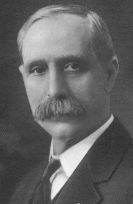 MR. M.H. HAGAMAN - was one of the
central figures in Ranger’s early
history and a major contributor to
Ranger’s progress. He came to Ranger
in the late 1880’s to teach school and
then served as school superintendent
for two years before going into business.
Always a civic leader, he became Ranger’s
first mayor when the city incorporated in
1919. He worked tirelessly for civic
improvements. Some of the veterans of the
Ranger oil boom considered Hagaman and
John Gholson to be the two men who had
MR. M.H. HAGAMAN - was one of the
central figures in Ranger’s early
history and a major contributor to
Ranger’s progress. He came to Ranger
in the late 1880’s to teach school and
then served as school superintendent
for two years before going into business.
Always a civic leader, he became Ranger’s
first mayor when the city incorporated in
1919. He worked tirelessly for civic
improvements. Some of the veterans of the
Ranger oil boom considered Hagaman and
John Gholson to be the two men who had
done more for Ranger in its early years than anyone else.
When he resigned as school superintendent, he founded the
Hagaman Hardware and Farm Implement Company. He eventually
went into partnership with Bohning Brothers in an extensive
wholesale and retail mercantile business, Bohning-Hagaman
Company. After the Company dissolved partnership, Hagaman
went into farming and ranching.
After the oil boom began, he founded the Hagaman Refining
Company and the Hagaman Water Works Company. Hagaman
Lake, which he built on his ranch, became Ranger’s first
reliable water supply and remained its water supply until
the creation of Lake Leon, dedicated in 1955. A filtration
plant built at Hagaman Lake at the time it became Ranger’s
water supply could handle 600,000 gallons of water a day.
Hagaman gave the City permission to build a sewage treatment
plant on his ranch.
Matthew Hilsman Hagaman was born October 11, 1861 to John
and Catharine Hagaman in Johnston County, Tennessee. He
was a graduate of the University of Tennessee. He and his
wife, Emma Whittington Hagaman, had three children who
survived infancy: Leslie (husband of longtime Ranger
teacher Helen Hagaman), Ruth, and Fred.
M.H. Hagaman, a Democrat, served two terms in the Texas
House of Representatives from January 1925 to January 1929.
While in the Legislature, he served on a number of committees,
among them Appropriations; Banks and Banking; Commerce and
Manufactures (which he chaired one term); Oil, Gas, and
Mining; and Conservation and Reclamation.
Hagaman died September 8, 1949 and is buried in Evergreen
Cemetery. Photo courtesy of the author’s collection.
CIVIC IMPROVEMENTS - Ranger voted to incorporate February 4,
1919, and on February 19, the first city officers were elected.
A city charter was adopted. The new city government set about
confronting problems common to many newly incorporated areas.
Among these were providing for utilities, a sewer system, a
hospital, a reliable water supply, and paving of streets.
Ranger Water Works, under the guidance of M.H. Hagaman, Ranger’s
first mayor, built a pump station at Hagaman Lake & a distribution
system. The City reached an agreement with Texas & Pacific
Railroad whereby the City could use the railroad’s pipe line,
already laid, to bring water to the City limits. Eventually
a filtration plant was built to insure a dependable source of
good water. At the time of its completion in 1919, it could
handle 600,000 gallons of water a day.
In 1919 bonds were issued to build a sewer system and begin
paving streets. At that time, the paving contract was one
of the largest paving contracts ever signed in Texas. It
called for 67 blocks to be completed by 1921. By the end
of that year all the business district and many blocks in
residential areas had been paved. Like many other Texas
cities, Ranger used bricks from the Thurber Brick Company
for paving streets.
School trustees had anticipated an enrollment of 1,000 in
1918, but 1,350 students showed up. A bond election passed,
and eventually Cooper, Young, Hodges Oak Park, and Tiffin
elementary school buildings were built. An elementary
school building was built at Merriman, not from bond funds
but rather from the school’s share of the royalties from
the Wagner No. 1 oil well built on the school property.
Tiffin and Merriman were not originally part of the Ranger
Independent School District. Still another bond issue was
passed in the early 1930’s for construction of the building
that eventually came to be called the recreation building.
Brick for that building came from the Tiffin elementary
school building, torn down in 1933.
Health care was a major concern, especially in light of
the 1918 flu epidemic that killed many people in Ranger and
throughout the country. Ranger’s first hospital, Ranger
General Hospital, opened in 1919 just south of Blundell
Street near Strawn Road. It had problems from the beginning,
including a lack of running water, inadequate sewage disposal,
and problems with electricity. Plans for a new hospital
began in 1920, but it was not until 1924 that a new hospital,
called Ranger City-County Hospital (also called Ranger
General Hospital) opened.
 JOHN McCLESKEY - Oil was discovered on
John McCleskey’s farm about a mile south
of downtown Ranger on October 17, 1917.
The McCleskey well ushered in Ranger’s
oil boom. John McCleskey—farmer, cattleman,
bricklayer, and oilman--used part of his
newly found wealth to build the McCleskey
Hotel. It became the site of many deals
involving oil and oil leases, many worth
hundreds of thousands of dollars. John
was a skilled bricklayer in addition to
being a farmer and cattleman, and, always
thrifty, he helped mix the mortar when
JOHN McCLESKEY - Oil was discovered on
John McCleskey’s farm about a mile south
of downtown Ranger on October 17, 1917.
The McCleskey well ushered in Ranger’s
oil boom. John McCleskey—farmer, cattleman,
bricklayer, and oilman--used part of his
newly found wealth to build the McCleskey
Hotel. It became the site of many deals
involving oil and oil leases, many worth
hundreds of thousands of dollars. John
was a skilled bricklayer in addition to
being a farmer and cattleman, and, always
thrifty, he helped mix the mortar when
construction began on his hotel.
It was said that Mrs. McCleskey became very angry when the oil
from the McCleskey well splattered her Leghorn chickens! Another
story, also quite likely apocryphal, was that she was asked what
she would do first with her new wealth. She replied that she
would buy a new ax. Scholars who have studied the folklore of
the oil field have said that the ax story and other such stories
involving the purchase of a relatively inexpensive item in the
wake of new wealth were very common.
John Rust, one of the interviewees in the Oral History of the
Texas Oil Industry (Dolph Briscoe Center for American History,
University of Texas) was living on a farm adjacent to the
McCleskeys’ farm when the discovery oil well came in. When
he heard the ax story, he said that he doubted it. He said
that Mrs. McCleskey would not have needed a new ax! Rust said
that if she mentioned getting a new ax, she was jesting.
John Hill McCleskey was born in Oakwood, Hall County, Georgia
September 24, 1854, the son of John L. and Emily McCleskey. As
a young man (some sources say he was 16 years old) he moved
to Fort Worth, where he farmed, raised livestock, and worked
with horses. In 1889 he moved to Ranger, settling on the farm
that became the site of the Ranger oil boom inaugural well. He
and his first wife, who preceded him in death, had four children
that survived infancy: Mary Emma, William Lafayette, John Tillman,
and George Hill.
John McCleskey did not live to see the completion of his hotel
or to enjoy his new wealth for very long. He was recovering
from typhoid fever when he developed massive indigestion from
eating some peaches and had a relapse. He died July 19, 1918.
He is buried in Merriman Cemetery.
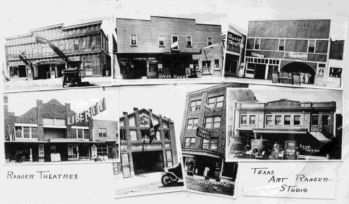 MOVIE THEATERS - In his book Lone Star Picture Shows (Texas A&M
University Press, 2001), Richard Schroeder points out that when
a Dallas audience in 1897 viewed the first motion picture ever
shown in Texas, Texans began a love affair with the movies.
Thomas Edison is credited with inventing the motion picture,
but it took contributions from innovators in chemistry, physics,
photography, and mechanical technology to bring his invention
to the point where it swept the nation in the early twentieth
century. Many towns and cities soon had motion picture venues
ranging from basic picture show theaters to so-called movie
palaces.
By 1920 Ranger had several theaters. The accompanying picture
shows seven of them: clockwise, from top left, the Hippodrome,
Opera House, Queen, Liberty (earlier called the Majestic and
pictured here in its original building), Lone Star (later called
the Columbia), Temple (later the Tower Theater), and Lamb Theater.
Other early theaters were the Eastside, Elite, Manhattan, and
Texas Theaters. The Rex Theater opened in 1922 in what was
described as the “old Liberty Theater building.”
The Liberty Theater and possibly some others not only showed
motion pictures but also hosted vaudeville performances. In
light of the devastating April 6, 1919 fire that destroyed
several blocks, an ad for the Liberty Theater in September
of that year claimed that it was fireproof At least two
theaters burned down in the 1919 and 1920 fires: an earlier
theater called the Majestic burned down in the 1919 fire,
and the Queen Theater burned down in 1920.
When the Lone Star Theater opened, it advertised that it
had the latest in projection equipment and a silver screen.
It promised “absolutely no eyestrain even in the front seats
and a rock-steady picture.” It also had a specially con-
structed organ, used to accompany the movie before “talkies.”
Ventilation was said to be perfect, making it unnecessary to
bring a fan. A 1934 ad for the Columbia Theater said that
children under the age of 12 could see the first episode of
“The Perils of Pauline” for a nickel.
Theater managers had their share of problems: a 1919 news
article said that the managers of the Liberty and Lone Star
Theaters had pleaded guilty to running Sunday shows in vio-
lation of state law and were assessed the minimum fine of
$20 each.
The Arcadia Theater, which replaced the Lamb Theater in 1929
after the latter was razed, had a pipe organ but showed only
talkies. The Arcadia was described as the most lavish movie
theater between Fort Worth and Abilene. Unlike most of the
earlier theaters, it had upholstered seats, deep carpets,
and velvet curtains. In 1942 owner and manager Brann Garner
put a large radio on the stage so that theatergoers could
hear at least one and possibly more of President Franklin
Roosevelt’s “Fireside Chats.” The Arcadia burned down in
1952. The Tower Theater had burned down earlier, and with
it and the Arcadia both gone, downtown Ranger was left with
no movie theaters.
Ranger’s only drive-in theater opened sometime in the early
1950’s and operated until sometime in the mid 1980’s.
Friday 13th, 2016 was a GOOD day for the Ranger Historical
Preservation Society. Phone rang at 9:19 AM and the voice
on the other end said - “is this the historical society?”
Of course the answer was yes - then “do you own those two
buildings on Austin Street...what do you plan to do with
them...?”
The decrepit buildings that stood in late 2016 was transformed
into a jewel for the City of Ranger. Photos were sent to the
Waggin’ Tongue on the progress of the remodel of the building
that was known as the Cole Apartments Upstairs and a restaurant
at ground level (Building on Left) and the Lone Star Theatre
(Building on Right). Eventually, those two building were
remodeled and in operation for a period of time.
MOVIE THEATERS - In his book Lone Star Picture Shows (Texas A&M
University Press, 2001), Richard Schroeder points out that when
a Dallas audience in 1897 viewed the first motion picture ever
shown in Texas, Texans began a love affair with the movies.
Thomas Edison is credited with inventing the motion picture,
but it took contributions from innovators in chemistry, physics,
photography, and mechanical technology to bring his invention
to the point where it swept the nation in the early twentieth
century. Many towns and cities soon had motion picture venues
ranging from basic picture show theaters to so-called movie
palaces.
By 1920 Ranger had several theaters. The accompanying picture
shows seven of them: clockwise, from top left, the Hippodrome,
Opera House, Queen, Liberty (earlier called the Majestic and
pictured here in its original building), Lone Star (later called
the Columbia), Temple (later the Tower Theater), and Lamb Theater.
Other early theaters were the Eastside, Elite, Manhattan, and
Texas Theaters. The Rex Theater opened in 1922 in what was
described as the “old Liberty Theater building.”
The Liberty Theater and possibly some others not only showed
motion pictures but also hosted vaudeville performances. In
light of the devastating April 6, 1919 fire that destroyed
several blocks, an ad for the Liberty Theater in September
of that year claimed that it was fireproof At least two
theaters burned down in the 1919 and 1920 fires: an earlier
theater called the Majestic burned down in the 1919 fire,
and the Queen Theater burned down in 1920.
When the Lone Star Theater opened, it advertised that it
had the latest in projection equipment and a silver screen.
It promised “absolutely no eyestrain even in the front seats
and a rock-steady picture.” It also had a specially con-
structed organ, used to accompany the movie before “talkies.”
Ventilation was said to be perfect, making it unnecessary to
bring a fan. A 1934 ad for the Columbia Theater said that
children under the age of 12 could see the first episode of
“The Perils of Pauline” for a nickel.
Theater managers had their share of problems: a 1919 news
article said that the managers of the Liberty and Lone Star
Theaters had pleaded guilty to running Sunday shows in vio-
lation of state law and were assessed the minimum fine of
$20 each.
The Arcadia Theater, which replaced the Lamb Theater in 1929
after the latter was razed, had a pipe organ but showed only
talkies. The Arcadia was described as the most lavish movie
theater between Fort Worth and Abilene. Unlike most of the
earlier theaters, it had upholstered seats, deep carpets,
and velvet curtains. In 1942 owner and manager Brann Garner
put a large radio on the stage so that theatergoers could
hear at least one and possibly more of President Franklin
Roosevelt’s “Fireside Chats.” The Arcadia burned down in
1952. The Tower Theater had burned down earlier, and with
it and the Arcadia both gone, downtown Ranger was left with
no movie theaters.
Ranger’s only drive-in theater opened sometime in the early
1950’s and operated until sometime in the mid 1980’s.
Friday 13th, 2016 was a GOOD day for the Ranger Historical
Preservation Society. Phone rang at 9:19 AM and the voice
on the other end said - “is this the historical society?”
Of course the answer was yes - then “do you own those two
buildings on Austin Street...what do you plan to do with
them...?”
The decrepit buildings that stood in late 2016 was transformed
into a jewel for the City of Ranger. Photos were sent to the
Waggin’ Tongue on the progress of the remodel of the building
that was known as the Cole Apartments Upstairs and a restaurant
at ground level (Building on Left) and the Lone Star Theatre
(Building on Right). Eventually, those two building were
remodeled and in operation for a period of time.
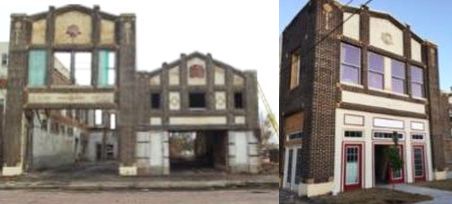 The vision of one young man and the RHPS changed these two
buildings, pictured above, to what they are today. The buildings
were donated to Chad Cunningham, with the stipulation, the
front of the buildings must remain as close to the original
as possible. Mr. Cunningham agreed and the work began.
In May 2016, The Lone Star Theatre Bar held an eventful grand
opening. The first event held was the 95th birthday party
for Mrs. Dorothy Anderson; a private family lunch with live
music, dancing and entertainment on May 14th. Although the
buildings now stand empty with a lack of patrons, the up-
stairs living area is occupied. Many still have the hope that
someone will see this “little jewel” and bring a business back
to Ranger but in the meantime someone is paying property taxes.
The vision of one young man and the RHPS changed these two
buildings, pictured above, to what they are today. The buildings
were donated to Chad Cunningham, with the stipulation, the
front of the buildings must remain as close to the original
as possible. Mr. Cunningham agreed and the work began.
In May 2016, The Lone Star Theatre Bar held an eventful grand
opening. The first event held was the 95th birthday party
for Mrs. Dorothy Anderson; a private family lunch with live
music, dancing and entertainment on May 14th. Although the
buildings now stand empty with a lack of patrons, the up-
stairs living area is occupied. Many still have the hope that
someone will see this “little jewel” and bring a business back
to Ranger but in the meantime someone is paying property taxes.
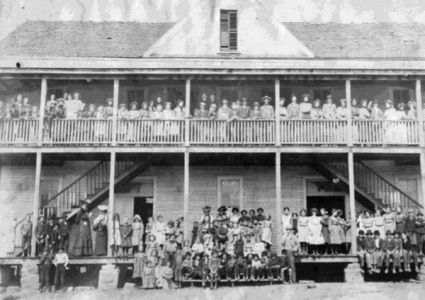 EARLY SCHOOLS - The first school building in the new town of Ranger
was a one-room frame schoolhouse built in 1880 on the site where
the high school was for many years. A private school, the Ray
Academy, operated in Ranger in the late 1890’s. Like some other
schools of the time, private or public, it was rather strict:
boys and girls were taught in separate classes. In the early-
to-mid 1880’s, a teacher’s salary of $60 a month was considered
especially generous. Opening in time for the 1886/87 school
year, the two-story frame building pictured here served all
grades until 1907, when a one-room building was built for primary
grade students. A two-story brick building was constructed in
1905 under the leadership of superintendent J. E. Temple Peters.
It served high school students until a new building opened in
1923. The senior class of 1977 was the last class to graduate
from that building. Walter Prescott Webb, a graduate of Ranger
High School before going on to a teaching career, including a
professorship at the University of Texas, recalled those early
high school classes many years later. They were, he said, a
mixture of the most unsophisticated country kids one could imagine
and sophisticated city kids: boys who knew how to wear a white
collar and the most charming girls, with bows in their hair and
buckles on their shoes. M.H. Hagaman, who had come to Ranger
to teach, was school superintendent in the late 1880’s. He
recalled that in 1889 there were about 150 students and three
teachers. The high school in those days served not only Ranger
students but also some from out of town. These students came
to Ranger because, in Hagaman’s words, it had a good high school
for that day. They boarded with local families.
HISTORY OF RANGER - Page 1
ARTICLES TO CONTINUE MONTHLY
EARLY SCHOOLS - The first school building in the new town of Ranger
was a one-room frame schoolhouse built in 1880 on the site where
the high school was for many years. A private school, the Ray
Academy, operated in Ranger in the late 1890’s. Like some other
schools of the time, private or public, it was rather strict:
boys and girls were taught in separate classes. In the early-
to-mid 1880’s, a teacher’s salary of $60 a month was considered
especially generous. Opening in time for the 1886/87 school
year, the two-story frame building pictured here served all
grades until 1907, when a one-room building was built for primary
grade students. A two-story brick building was constructed in
1905 under the leadership of superintendent J. E. Temple Peters.
It served high school students until a new building opened in
1923. The senior class of 1977 was the last class to graduate
from that building. Walter Prescott Webb, a graduate of Ranger
High School before going on to a teaching career, including a
professorship at the University of Texas, recalled those early
high school classes many years later. They were, he said, a
mixture of the most unsophisticated country kids one could imagine
and sophisticated city kids: boys who knew how to wear a white
collar and the most charming girls, with bows in their hair and
buckles on their shoes. M.H. Hagaman, who had come to Ranger
to teach, was school superintendent in the late 1880’s. He
recalled that in 1889 there were about 150 students and three
teachers. The high school in those days served not only Ranger
students but also some from out of town. These students came
to Ranger because, in Hagaman’s words, it had a good high school
for that day. They boarded with local families.
HISTORY OF RANGER - Page 1
ARTICLES TO CONTINUE MONTHLY
EARLY WATER SOURCES - The lack of a dependable source of water was a major problem confronting the new settlement of Ranger. One of the first attempts at solving the problem was a well dug in the middle of Locust Street (later called Main Street) about half a block west of the present intersection of Main & Commerce Streets.
FIRE - Ranger had little fire protection in the early days, especially before there was a reliable municipal water supply. Before the city incorporated in 1919 and got what was at the time considered modern fire- fighting equipment, fire- fighting was done by volunteers, often in bucket brigades. Sometimes fire-
LAW ENFORCEMENT - Law enforcement in Ranger Camp Valley was in the hands of the Texas Rangers. They provided protection against frequent Indian raids and bandits in sparsely settled com- munities. Even after Ranger had a police force, the Texas Rangers continued to be involved in resolving some crimes, such as
HOTELS - In her History of Eastland County, Texas (Dallas, A.D. Aldridge, 1904), Mrs. George Langston said that a Mr. Griffin “did a thriving hotel business” in a tent beginning around 1880. Another early hotel was run by Mr. and Mrs. John Bryant from Illinois. They began
MR. M.H. HAGAMAN - was one of the central figures in Ranger’s early history and a major contributor to Ranger’s progress. He came to Ranger in the late 1880’s to teach school and then served as school superintendent for two years before going into business. Always a civic leader, he became Ranger’s first mayor when the city incorporated in 1919. He worked tirelessly for civic improvements. Some of the veterans of the Ranger oil boom considered Hagaman and John Gholson to be the two men who had
JOHN McCLESKEY - Oil was discovered on John McCleskey’s farm about a mile south of downtown Ranger on October 17, 1917. The McCleskey well ushered in Ranger’s oil boom. John McCleskey—farmer, cattleman, bricklayer, and oilman--used part of his newly found wealth to build the McCleskey Hotel. It became the site of many deals involving oil and oil leases, many worth hundreds of thousands of dollars. John was a skilled bricklayer in addition to being a farmer and cattleman, and, always thrifty, he helped mix the mortar when
MOVIE THEATERS - In his book Lone Star Picture Shows (Texas A&M University Press, 2001), Richard Schroeder points out that when a Dallas audience in 1897 viewed the first motion picture ever shown in Texas, Texans began a love affair with the movies. Thomas Edison is credited with inventing the motion picture, but it took contributions from innovators in chemistry, physics, photography, and mechanical technology to bring his invention to the point where it swept the nation in the early twentieth century. Many towns and cities soon had motion picture venues ranging from basic picture show theaters to so-called movie palaces. By 1920 Ranger had several theaters. The accompanying picture shows seven of them: clockwise, from top left, the Hippodrome, Opera House, Queen, Liberty (earlier called the Majestic and pictured here in its original building), Lone Star (later called the Columbia), Temple (later the Tower Theater), and Lamb Theater. Other early theaters were the Eastside, Elite, Manhattan, and Texas Theaters. The Rex Theater opened in 1922 in what was described as the “old Liberty Theater building.” The Liberty Theater and possibly some others not only showed motion pictures but also hosted vaudeville performances. In light of the devastating April 6, 1919 fire that destroyed several blocks, an ad for the Liberty Theater in September of that year claimed that it was fireproof At least two theaters burned down in the 1919 and 1920 fires: an earlier theater called the Majestic burned down in the 1919 fire, and the Queen Theater burned down in 1920. When the Lone Star Theater opened, it advertised that it had the latest in projection equipment and a silver screen. It promised “absolutely no eyestrain even in the front seats and a rock-steady picture.” It also had a specially con- structed organ, used to accompany the movie before “talkies.” Ventilation was said to be perfect, making it unnecessary to bring a fan. A 1934 ad for the Columbia Theater said that children under the age of 12 could see the first episode of “The Perils of Pauline” for a nickel. Theater managers had their share of problems: a 1919 news article said that the managers of the Liberty and Lone Star Theaters had pleaded guilty to running Sunday shows in vio- lation of state law and were assessed the minimum fine of $20 each. The Arcadia Theater, which replaced the Lamb Theater in 1929 after the latter was razed, had a pipe organ but showed only talkies. The Arcadia was described as the most lavish movie theater between Fort Worth and Abilene. Unlike most of the earlier theaters, it had upholstered seats, deep carpets, and velvet curtains. In 1942 owner and manager Brann Garner put a large radio on the stage so that theatergoers could hear at least one and possibly more of President Franklin Roosevelt’s “Fireside Chats.” The Arcadia burned down in 1952. The Tower Theater had burned down earlier, and with it and the Arcadia both gone, downtown Ranger was left with no movie theaters. Ranger’s only drive-in theater opened sometime in the early 1950’s and operated until sometime in the mid 1980’s. Friday 13th, 2016 was a GOOD day for the Ranger Historical Preservation Society. Phone rang at 9:19 AM and the voice on the other end said - “is this the historical society?” Of course the answer was yes - then “do you own those two buildings on Austin Street...what do you plan to do with them...?” The decrepit buildings that stood in late 2016 was transformed into a jewel for the City of Ranger. Photos were sent to the Waggin’ Tongue on the progress of the remodel of the building that was known as the Cole Apartments Upstairs and a restaurant at ground level (Building on Left) and the Lone Star Theatre (Building on Right). Eventually, those two building were remodeled and in operation for a period of time.
The vision of one young man and the RHPS changed these two buildings, pictured above, to what they are today. The buildings were donated to Chad Cunningham, with the stipulation, the front of the buildings must remain as close to the original as possible. Mr. Cunningham agreed and the work began. In May 2016, The Lone Star Theatre Bar held an eventful grand opening. The first event held was the 95th birthday party for Mrs. Dorothy Anderson; a private family lunch with live music, dancing and entertainment on May 14th. Although the buildings now stand empty with a lack of patrons, the up- stairs living area is occupied. Many still have the hope that someone will see this “little jewel” and bring a business back to Ranger but in the meantime someone is paying property taxes.
EARLY SCHOOLS - The first school building in the new town of Ranger was a one-room frame schoolhouse built in 1880 on the site where the high school was for many years. A private school, the Ray Academy, operated in Ranger in the late 1890’s. Like some other schools of the time, private or public, it was rather strict: boys and girls were taught in separate classes. In the early- to-mid 1880’s, a teacher’s salary of $60 a month was considered especially generous. Opening in time for the 1886/87 school year, the two-story frame building pictured here served all grades until 1907, when a one-room building was built for primary grade students. A two-story brick building was constructed in 1905 under the leadership of superintendent J. E. Temple Peters. It served high school students until a new building opened in 1923. The senior class of 1977 was the last class to graduate from that building. Walter Prescott Webb, a graduate of Ranger High School before going on to a teaching career, including a professorship at the University of Texas, recalled those early high school classes many years later. They were, he said, a mixture of the most unsophisticated country kids one could imagine and sophisticated city kids: boys who knew how to wear a white collar and the most charming girls, with bows in their hair and buckles on their shoes. M.H. Hagaman, who had come to Ranger to teach, was school superintendent in the late 1880’s. He recalled that in 1889 there were about 150 students and three teachers. The high school in those days served not only Ranger students but also some from out of town. These students came to Ranger because, in Hagaman’s words, it had a good high school for that day. They boarded with local families. HISTORY OF RANGER - Page 1 ARTICLES TO CONTINUE MONTHLY